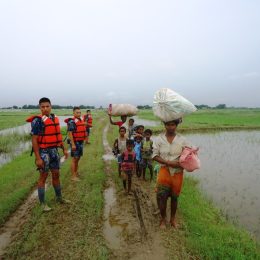Exposing vulnerabilities in the road network
Major roads in the Alps are vulnerable to flooding from rivers. That is the conclusion of a study by Deltares and Amsterdam VU-University that was published in 2021. Among other things, it identified high-risk locations of this kind. The researchers used a new technique to calculate in very fine detail the flood risks for every road in Europe, from major motorways to urban alleyways. Investment banks and national road authorities can now identify the weakest links in the road network and improve the climate resilience of the network.

From the global to the urban scale
The study stands out because the analysis at the European level provides an action perspective at the local level. “European and local studies used to be two different worlds,” says Kees van Ginkel, the lead author of the article and a climate adaptation expert at Deltares.
“By combining large datasets such as OpenStreetMap with new computational techniques, we now have a method where you can analyse vulnerable clusters on both the global scale and the urban scale in a short time.”
It is also possible to identify damage to different types of road accurately. Local knowledge about damage was used to integrate damage functions in the analysis that were then applied on a global scale using big data techniques.
The study compared all the European countries with each other and it identified vulnerable clusters such as the Alps. It is striking that the risk of major river floods is small in the Netherlands because of our high level of protection but that, at the same time, a large part of the road network would be shut down during flooding. This shows how important it is to look not just at the costs of road repair but also at the other effects on society. These include the options for evacuation, access to an area during a flood and possible detours.
Building a climate-resilient road network with the RA2CE toolkit
The method used in this analysis has been added to the RA2CE toolbox for road analysis. RA2CE (Risk Assessment and Adaptation for Critical Infrastructure) helps government authorities and road managers in the Netherlands and abroad to establish a quick picture of the climate resilience of their road network and to set their ambitions on the basis of the facts.
“It’s important to identify high-risk areas accurately,” says Thomas Bles, an expert on climate-resilient networks at Deltares. “We have also applied the new method for Rijkswaterstaat. Thousands of flood scenarios were calculated and interpreted for the national roads in the Netherlands in just a short period of time. The vulnerabilities that emerge can be used as the basis for a risk dialogue about what is acceptable, and what isn’t. This helps Rijkswaterstaat to tackle the weak spots when they replace or repair a road.”
Bles emphasises that there can be major differences in the interpretation of ‘blue spots’ in terms of direct damage (repairing the road) or indirect damage (social disruption). “Before a workshop in the Philippines, road managers drew on their experience to identify a number of weak spots where they wanted to invest in road improvements. After seeing our analysis and maps, that also identified the impact on road users, there were major changes to the locations on their lists.” In that way, the toolkit helps to direct investments in climate-resilient infrastructure to the right locations.
The method can also be used to analyse the transport links for specific factories. During the first COVID-19 wave, it became clear that delayed deliveries can cost car manufacturers a lot of money. The question now is whether flooding can have a similar effect. So it was decided to conduct a study for one European car manufacturer to identify suppliers who may be difficult to reach during floods.
Appeal to road managers
The study was published in the journal Natural Hazards and Earth System Sciences (NHESS) and it is part of the European project COACCH. The flood data has been made available by the European Commission. The authors are appealing to national road managers to share their experiences with flooding so that damage assessments can be made even more accurate.




